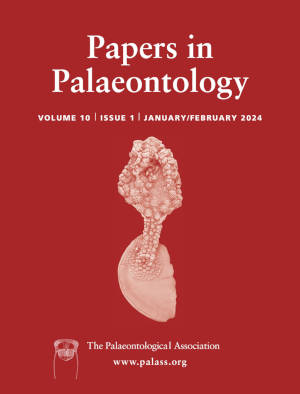Article: Chitinozoan response to the ‘Kellwasser events’: population dynamics and morphological deformities across the Frasnian–Famennian mass extinction
Publication: Papers in Palaeontology
Volume:
10
Part:
3
Publication Date:
2024
Article number:
e1557
Author(s):
Tim De Backer, James (Jed) E. Day, Poul Emsbo, Patrick I. McLaughlin, and Thijs R.A. Vandenbroucke
DOI:
10.1002/spp2.1557
Abstract
Abstract Fossil (zoo)plankton dynamics during Devonian ocean-anoxic and extinction events can shed light on the palaeoceanographic and geochemical processes that shaped the middle Palaeozoic biosphere. However, datasets on (Upper) Devonian marine palynology, illustrating such dynamics, remain underexplored. The type section of the Sweetland Creek Shale in Iowa (USA) offers a detailed conodont zonation for the upper Frasnian and across the Frasnian–Famennian boundary, records the Upper and Lower Kellwasser events and has pristine preservation of organic material, making this an ideal section to study the effects of this catastrophic event on chitinozoan zooplankton populations. A total of 3998 specimens were recovered, imaged and classified into 12 distinct species, 10 of which were previously unknown. This study demonstrates the unrealized potential of chitinozoans as a regional biostratigraphic tool in the Upper Devonian. The Lower Kellwasser Event is characterized by a drop in chitinozoan abundance and the run up to the Upper Kellwasser Event marks a period of rapid species turnover rates. Interestingly, every assemblage in this interval is nearly monospecific. Patterns of changing spine morphologies in Fungochitina pilosa, Ramochitina sp. A and Saharochitina sp. A are herein explored as potential ecophenotypic expressions. We identify Angochitina monstrosa as a new disaster species. The discovery of two teratological chitinozoans specimens, in combination with the presence of the disaster species Angochitina monstrosa and deformation in contemporaneous conodonts, supports our previous discovery that marine teratology is a feature of many Palaeozoic extinction events, possibly triggered by the injection of hydrothermal brines into the ocean.
